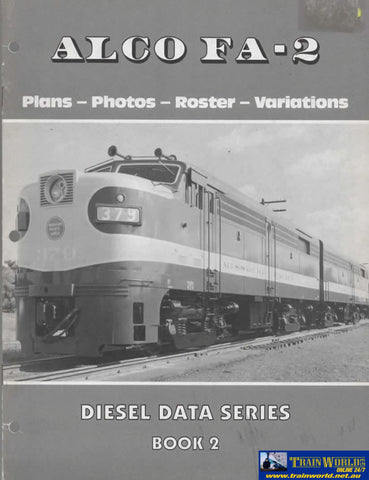Diesel Data Series Book #02: Alco FA-2 'Plans, Photos, Roster & Variations' (UHUN-FA2)
Product No.: UHUN-FA2
Title: Diesel Data Series Book #02: Alco FA-2 'Plans, Photos, Roster & Variations'
Author(s): Peck, David
Illustrator(s): N/A
Publisher: Hundman Publishing
ISBN: N/A
Condition: New
Binding: Softcover
Dust Jacket: None
Edition: 1st Edition
Publication Year: Appox. 1990
Features: 18 Pages with Black/White Photos & Line Drawings.
The ALCO FA was a family of B-B diesel locomotives designed to haul freight trains. The locomotives were built by a partnership of ALCO and GE in Schenectady, New York, between January 1946 and May 1959. They were of a cab unit design, and both cab-equipped lead (A unit) FA and cabless booster (B unit) FB models were built. A dual passenger-freight version, the FPA/FPB, was also offered. It was equipped with a steam generator for heating passenger cars.
Externally, the FA and FB models looked very similar to the ALCO PA models produced in the same period. Both the FA and PA models were styled by GE's Ray Patten. They shared many of the same characteristics both aesthetically and mechanically. It was the locomotive's mechanical qualities (the ALCO 244 V-12 prime mover) and newer locomotive models from both General Motors Electro-Motive Division (EMD) and General Electric (the partnership with ALCO was dissolved in 1953) that ultimately led to the retirement of the FA/FB locomotive model from revenue service.
Several examples of FAs and FBs have been preserved in railroad museums, a few of them in operational status on such lines as the Grand Canyon Railway and the Napa Valley Wine Train. The FAs, as well as their cousins, the ALCO PAs, were born as a result of Alco's development of a new diesel engine design, the Model 244. In early 1944, development started on the new design, and by November 1945, the first engines were beginning to undergo tests. This unusually short testing sequence was brought about by the decision of Alco's senior management that the engine and an associated line of road locomotives had to be introduced no later than the end of 1946.
In preparation for this deadline, by January 1946, the first four locomotives with the 244 engines had been built. Two FA-1s and an FB-1 were painted in Alco Demonstrator colors and were released for road tests for a month and a half on the Delaware and Hudson Railway. A strike at Alco delayed production beyond the first four units and delivery of the first units, to the Gulf, Mobile and Ohio Railroad, began in May 1946, and continued into early 1947, totaling 80 units. At the end of this run, Alco upgraded the generators in the locomotives, with the first of these models entering service in February 1947 for the New York Central. In 1950, the Montreal Locomotive Works, an affiliate of Alco, began production of FAs as well. In the Fall of 1950, an upgraded model, the FA-2, was launched.
This model featured an uprated Model 244 engine, with an output of 1600 horsepower. Additionally, the carbody was lengthened, making possible the addition of a steam generator in the A unit to allow for passenger service. Models equipped as such were designated the FPA-2/FPB-2. The first FA-2s were delivered in October 1950 to the Baltimore and Ohio and the Erie. By this time, however, the cab unit had fallen out of favor due to the greater versatility of road switchers, and U S production of the FA line ended in 1956, with Canadian production ending in 1959.



